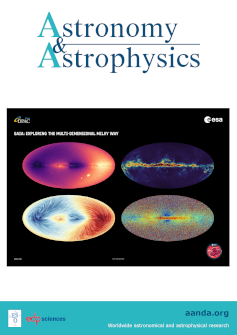The CHIMERA Survey: The first CO detection in Leo T, the lowest mass known galaxy still hosting cold molecular gas
IF 5.8
2区 物理与天体物理
Q1 ASTRONOMY & ASTROPHYSICS
引用次数: 0
Abstract
We report the first CO detection in Leo T, representing the most extreme observation of carbon monoxide molecules in the lowest stellar mass gas-rich dwarf galaxy (M⋆ ∼ 105 M⊙) known to date. We acquired and present new Atacama Compact Array (ACA) 12CO(J = 1–0) data within our CHIMERA Survey project for the central region of Leo T, a metal-poor ([M/H] ∼ −1.7) dwarf in the Milky Way (MW) outskirts. We identified three compact molecular clouds (< 13 pc) with estimated upper limit virial masses of Mmol ∼ 5 × 103 M⊙ each and a total of 1.4 ± 0.4 × 104 M⊙, corresponding to ∼3% of the total gas mass. We obtained CO-to-H2 conversion factors (αCO) as high as ∼ 155 M⊙(K km s−1 pc2)−1 and mean molecular gas surface densities of Σmol ∼ 9 M⊙ pc−2 that are consistent with values found in dwarf galaxies with extremely low metal content. All CO clouds are shifted (∼60 pc) from the stellar population centers, and only one cloud appears within the densest HI region. Two clouds have velocity offsets with the HI of Δvlos ∼ + 13 km s−1 being within twice the velocity dispersion (Δvlos/σHI, los ∼ 2) and probably bound. However, the northern cloud is faster (Δvlos ∼ + 57 km s−1); our models with low halo masses (Mh ≲ 109 M⊙) result in unbound orbits, suggesting that this material is likely being expelled from the dwarf, providing evidence for molecular gas depletion. These properties reveal a perturbed dynamics intertwined with star formation processes in low-mass dwarf galaxies, supporting a scenario of episodic bursts until they are fully quenched by the MW environment.奇美拉巡天:首次在Leo T探测到一氧化碳,这是已知质量最低的星系,仍然存在冷分子气体
我们报告了在Leo T中首次探测到一氧化碳,代表了迄今为止已知的最低恒星质量富气体矮星系(M - ~ 105 M⊙)中一氧化碳分子的最极端观测。我们在我们的CHIMERA调查项目中获得并展示了新的阿塔卡马紧凑型阵列(ACA) 12CO(J = 1-0)数据,用于狮子座T的中心区域,这是一个位于银河系(MW)外围的金属贫乏([M/H] ~ - 1.7)矮星。我们确定了三个紧凑的分子云(< 13 pc),估计每个分子云的病毒质量上限为Mmol ~ 5 × 103 M⊙,总质量为1.4±0.4 × 104 M⊙,相当于总气体质量的~ 3%。我们获得了CO-to-H2转换因子(αCO)高达~ 155 M⊙(K km s−1 pc2)−1,平均分子气体表面密度为Σmol ~ 9 M⊙pc−2,与金属含量极低的矮星系的值一致。所有的CO云都从恒星群中心移动了(约60个百分点),只有一个云出现在密度最大的HI区域。有两种云的速度偏移,其HI为Δvlos ~ + 13 km s−1,在速度色散(Δvlos/σHI, los ~ 2)的两倍之内,并且可能受到约束。然而,北部云更快(Δvlos ~ + 57 km s−1);我们的模型具有低晕质量(Mh > 109 M⊙),结果是没有束缚的轨道,这表明这些物质很可能是从矮星中被驱逐出来的,为分子气体耗尽提供了证据。这些特性揭示了低质量矮星系中恒星形成过程的扰动动力学,支持了一种偶发性爆发的情景,直到它们被MW环境完全淬灭。
本文章由计算机程序翻译,如有差异,请以英文原文为准。
求助全文
约1分钟内获得全文
求助全文
来源期刊

Astronomy & Astrophysics
地学天文-天文与天体物理
CiteScore
10.20
自引率
27.70%
发文量
2105
审稿时长
1-2 weeks
期刊介绍:
Astronomy & Astrophysics is an international Journal that publishes papers on all aspects of astronomy and astrophysics (theoretical, observational, and instrumental) independently of the techniques used to obtain the results.
 求助内容:
求助内容: 应助结果提醒方式:
应助结果提醒方式:


